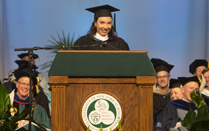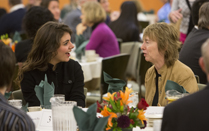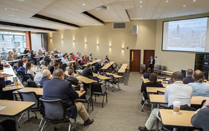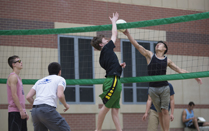Binghamton University President Harvey Stenger's Quarterly Report - June 30, 2015
Binghamton University is an interesting place in the weeks following Commencement. There is a striking transition from the bustle of the last weeks of the academic year to the more relaxed days of summer. With most students home for the summer, there are days when the Peace Quad seems quieter — and it’s definitely easier to find a parking space. But this stillness is deceptive, as our faculty and staff — and yes, our students, too — keep the campus humming.
This year, the spring quarter has been especially busy. We’ve successfully graduated another class, and are now in the process of welcoming next year’s students. Summer courses are underway, though most students opt to learn online. Faculty are busy with research, and the University is strengthening its role in regional economic development while taking the next steps on the Road Map to Premier.
I’m proud to note, as well, that Binghamton was recognized on the last day of this quarter with the prestigious national designation as an “Innovation & Economic Prosperity University” by the Association of Public Land-grant Universities. We are the only SUNY school, and in fact the only school in New York state, to receive this recognition for our strong commitment to economic engagement through innovation and entrepreneurship, technology transfer, talent and workforce development, and community development. We continue to be a significant player in the economic development of Binghamton, the Southern Tier and New York state, and we are honored to earn this designation.
These are exciting times at Binghamton, and I am looking forward to additional progress in the months ahead.
Commencement
The 2014-15 academic year concluded with an exciting and fun series of Commencement exercises (eight in all), during which more than 3,400 students entered the ranks of Binghamton alumni. The campus was exceptionally busy, with graduates inviting more than 22,000 family members and friends to campus to share in the excitement. With so many people on campus, Commencement is not only a big deal for our campus, but also provides a real economic boost for the region. We estimate that it generates over $1.65 million for the local economy, and more than $2.66 million for the entire Southern Tier.
One of the highlights of Commencement for me is being able to present honorary degrees to individuals who serve as exemplars and role models for the University community. This year, we recognized three individuals – Horace Gibson, founder of the International School in Florence, Italy (at 95 years old, Mr. Gibson was undoubtedly one of the oldest honorary degree recipients in the nation); philosopher Jason Stanley; and Tien Wu, chief operating officer and member of the board of directors of Advanced Semiconductor Engineering, Inc. Cheol Kyo Kim, president and CEO of Samsung Techwin in South Korea, received a University Medal for his work to develop international partnerships with the University.
We also recognized Dr. Yasmin Hurd ’82, Dr. Salvatore Caruana ’73, Howard Unger and Stephanie Courtney with alumni awards. Courtney, who is better known as “Flo“ in the Progressive Insurance commercial campaign, gave a great speech urging graduates to “dare to be Imperfect,” while 11 different students provided speeches across our eight ceremonies that were at turns humorous, poignant and inspiring. We also were honored to have U.S. Sen. Charles Schumer on hand to help recognize our graduates and share with them some of his great stories and remarks.
Orientation and summer classes
With Commencement over, summer remains busy with four orientation sessions for transfer students just completed, to be followed in July by eight freshman orientation sessions. Each year, the University incorporates new sessions and modifies the presentations so students have up-to-date information and are aware of the many opportunities and services available to them here. For example, this year, new sessions include information about the Fleishman Center for Career and Professional Development, the Multicultural Resource Center, our Freshman Research Immersion program and new study abroad opportunities for students. The orientation sessions serve as a follow-up to the open houses that were held in March and April that attracted nearly 3,000 potential students.
Meanwhile, many current students are busy taking classes, though only a portion of them are on campus. This summer, more than 400 different courses will be taught, with nearly 60 percent of them being offered online. By the end of the summer, more than 3,200 students, drawn from every school on campus, will have participated in a summer course. The increased demand for online courses is a product of both advances in teaching technology and a change in student culture, with more students wanting to take advantage of the opportunities for summer employment and returning home, while also reducing their length of time to graduation.
Faculty are hard at work
One of the things that faculty members most appreciate about the summer months is the opportunity to concentrate on their research, scholarship and creative endeavors. While they are active all year round, many (but certainly not all) faculty have a break from teaching, and they use these months to focus on their research and scholarship. I am especially impressed that both the quantity and quality of discovery continues to increase at Binghamton. In fact, research expenditures at Binghamton increased by 8 percent last year in spite of a difficult funding climate. Even more impressive is the increase in the number of research sponsorship awards, which have exploded from 42 in 2013-14 to 138 in 2014-15.
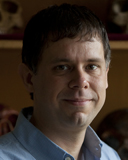
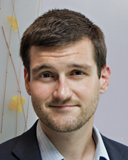

The growth in research and scholarship at Binghamton is resulting in increased recognition in the national and international press. During the past three months alone, University research has been mentioned in media ranging from Popular Science and Science Daily to The New York Times and The Wall Street Journal. Binghamton’s talent for discovery and creation is evident across the University. For example, electrical and computer engineering Assistant Professor Seokheun “Sean” Choi has received a $300,000 National Science Foundation grant to develop “origami” batteries powered by bacteria; School of Management Assistant Professor Seth Spain was cited for his work tracing leadership behaviors in the Transformer series of comic books and movies; and anthropology Assistant Professor Rolf Quam received publicity for his work in identifying a 430,000 year-old skull that showed evidence of intentional injury in what has been dubbed “the world’s oldest murder.”


Recognition of the work of the University’s faculty extends beyond the popular press, with SUNY recently announcing the promotion of two members of the Department of Electrical and Computer Engineering – Jessica Fridrich and Mark Fowler – to the respective ranks of distinguished professor and distinguished teaching professor. Fridrich was recognized for her work in steganography and steganalysis (hiding and detecting messages) in digital media, and in particular, her 2004 discovery that cameras leave forensic evidence in the form of “digital fingerprints.” Similarly, Fowler was cited for his innovative teaching practices, beginning with his work as an “early adopter” of online teaching and his efforts to “flip” classroom teaching, with readings and video lectures done as homework, while in the classroom students participates in exercises designed to foster hands-on learning. Congratulations to both of them.
Changes in leadership

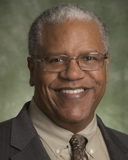
welcome two new individuals to our senior administration in positions that have a critical role to play on campus, in particular in terms of supporting student education and faculty research. Curtis Kendrick has been appointed our new dean of Libraries and Sharon Pitt is our new chief information officer for Information Technology Services. At the same time, I want to recognize Decker School of Nursing (DSON) Dean Joyce Ferrario, who is stepping down to return to the nursing faculty. Ferrario’s leadership has been marked by a number of significant achievements, including internationalizing DSON’s curriculum, introducing new teaching technologies, and most of all, strengthening research and graduate education. The University will be conducting a national search for her successor; meanwhile Pamela Stewart Fahs, professor and Decker Endowed Chair of Rural Health Nursing, will serve as interim dean.
Campus Climate Survey and Students for Change
Three years ago when we announced the strategic goals in our Road Map, the University reiterated its commitment to being a diverse, inclusive and welcoming campus. As part of this effort, the Office of Diversity, Equity and Inclusion (ODEI) conducted our first Campus Climate Survey to provide metrics for students, faculty and staff across the University to learn more about the institutional climate, inclusion and work-life issues on our campus. The lengthy process of developing, conducting and analyzing the survey concluded in April 2015, with the release of the Campus Climate Survey report. Based on the report’s findings, ODEI will develop action plans and strategic initiatives to improve the overall campus climate and to inform programmatic initiatives and policies moving forward.
Over the course of the last three months, the need to promote diversity and inclusion on campus was emphasized by a group of campus community members organized as Students for Change. In particular, these students were concerned about issues of harassment and discrimination and how the campus administration works to address them. I met with this organization several times, including at a lengthy town hall meeting. I stressed the importance with which the University views their concerns and how the campus is working to increase diversity and to make the campus a place that respects all its members; following these meetings I submitted an open letter to the community in the University student newspaper in which I detailed some of the actions that the campus has taken as we pursue these goals. This is an issue that has been, and will continue to be, one of the highest priorities in my tenure as president.
Progress on the Road Map
We also are moving forward on a number of other strategic goals as part of the Road Map process. With the Road Map now in its third year, we continue to solicit proposals to advance our strategic priorities from the campus community. This year, we received 93 proposals from across the University for 2016-2017 funding. These were then reviewed by the Road Map Steering Committee, Faculty Senate, Professional Employees Council and student representatives who identified 27 proposals for further consideration. The Faculty Senate Budget Review Committee and the Road Map Steering Committee recently completed ranking these proposals and the results were announced, with 14 of the 27 proposals receiving some level of funding. I am very pleased with this process, as strong proposals have emerged that address each of our strategic priorities. As always, this is a very competitive process, and I am encouraged that the campus community is working to make Binghamton the premier public University.
A main focus of the Road Map has been to establish the School of Pharmacy and Pharmaceutical Sciences (SOPPS) that will be located in Johnson City. We continue to make excellent progress on this goal; the facility design is nearly complete and we are on track to break ground in the spring of 2016. Dean Gloria Meredith is in the process of hiring the school’s senior leadership team and we will begin faculty recruitment in the coming months. In addition, we are forming an advisory board for the school to help provide strategic and tactical guidance. For more information about the school, visit its website here. I recently met with a group of Johnson City residents and political leaders, and I can say that the area is unequivocal in its support for the new school.
Economic development initiatives
The School of Pharmacy and Pharmaceutical Sciences forms the centerpiece of the Southern Tier’s economic development plans for this round of the Regional Economic Development Council (REDC) funding, as well as its proposal for New York states’ Upstate Revitalization Initiative (URI). These are very significant programs, with the potential for funding for the URI being in excess of $500 million over the course of five years. The Southern Tier REDC is currently finalizing its proposals, which focus on the development of a new Southern Tier Health Sciences and Technology Innovation Park to be located adjacent to the new School of Pharmacy and Pharmaceutical Sciences. Our goal to establish a healthcare ecosystem in the region surrounding Wilson Hospital and the SOPPS.
Our plan is to grow the regional medical infrastructure — the cohort of doctors, nurses, biomedical researchers and life scientists that work in one of the fastest-growing sectors of the economy. Toward this end, we envision building a new healthcare campus that will bring together the Decker School of Nursing and the Clinical Campus of Upstate Medical University. Apart from providing space for teaching and learning near one of the region’s largest hospitals, we also see these facilities housing research and clinical facilities to support advances in such related areas as rehabilitation and regeneration technologies. In addition, we see the development of a biopharmaceutical hub as well as space for research and production for medical 3D printing. This is research and education that is at the forefront of medical science, and would position Binghamton University and the region for decades of future growth — both in terms of jobs and national reputation.
The University’s role in economic development was on U.S. Sen. Kirsten Gillibrand’s mind when she toured the Engineering and Science Building this spring to publicize a bill that she is sponsoring in the U.S. Senate. The Manufacturing Universities Act of 2015 would provide federal support for academic programs that are related to manufacturing, either through direct partnerships or through educating engineers and scientists who will enter careers in manufacturing. And speaking of senators, U.S. Sen. Charles Schumer recently provided critical assistance for the University, helping it secure nearly $3 million in funding from the Federal Emergence Management Agency (FEMA) for critical repairs that the University Downtown Center required following the floods of 2011. It is rewarding that our political leaders recognize the important role that the campus plays in the community and in New York state, and are thus willing to step forward to support us.
Athletic success
Finally, as the last days of the quarter wound down, two Binghamton University athletes, senior middle-distance runner Jesse Garn and sophomore long-jumper Keishorea Armstrong, advanced to the NCAA Division I Track and Field championship at the University of Oregon. Finishing 24th, Armstrong was named honorable mention All-American by the United States Track & Field and Cross Country Coaches’ Association, while Garn, with a fourth place finish in the 800, received first-team All-America honors. Congratulations to both of them, and to all the athletes who represent Binghamton University.
As you can see, it’s been a very busy quarter at Binghamton University — just the way we like it.
Sincerely,

Harvey G. Stenger


